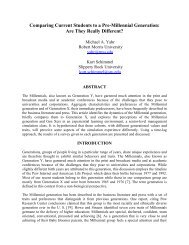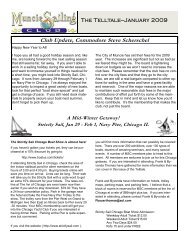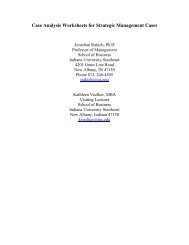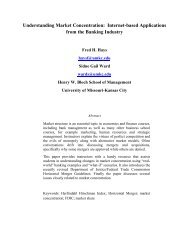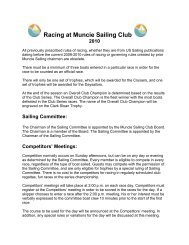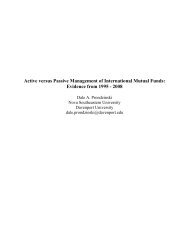The Balanced Scorecard with Time-Driven Activity Based-Costing ...
The Balanced Scorecard with Time-Driven Activity Based-Costing ...
The Balanced Scorecard with Time-Driven Activity Based-Costing ...
You also want an ePaper? Increase the reach of your titles
YUMPU automatically turns print PDFs into web optimized ePapers that Google loves.
cause quality to suffer. G.H. Felix and J.L. Riggs introduced the performance matrix in 1986 as a<br />
possible solution to such a problem. <strong>The</strong> matrix was composed of a group of performance<br />
measures that are priority weighted. <strong>The</strong> sum of the weighted measures is computed to reflect a<br />
balanced “performance index” or “success indicator”. Pay based on the index, rather than the<br />
individual performances, ensures that employees attend to all the key performances associated<br />
<strong>with</strong> their jobs. Robert Kaplan and David Norton expanded the concept of balanced performance<br />
in 1992 to include performances that affect future organizational outcomes, learning, and growth.<br />
<strong>The</strong> basic concept came to be called the balanced scorecard [1].<br />
<strong>The</strong> balanced scorecard is a customer-based planning and process improvement system<br />
aimed at focusing and driving the change process. It does this by translating strategy into an<br />
integrated set of financial and non-financial measures that communicates the organizational<br />
strategy to the employees and provides them <strong>with</strong> actionable feedback and attainment of<br />
objectives.<br />
According to Fielden [9], corporations across the world have begun leveraging the power of<br />
balanced scorecards for converting vision and strategy into measurable targets. Introduced in<br />
1991 by Robert S. Kaplan and David P. Norton as a management tool, balanced scorecards<br />
provide executives <strong>with</strong> the ability to develop measures that could accurately forecast the health<br />
and wealth of an organization. By providing the ability to translate strategy into action rapidly,<br />
measurably, and knowledgeably, a balanced scorecard aligns that strategy <strong>with</strong>in an<br />
organizational structure to tap into hidden assets and knowledge. Moreover, by connecting both<br />
internal and external people <strong>with</strong> these strategies, continual learning and growth can be achieved.<br />
According to Bailey, Chow, and Haddad [3], a partial list of users of balanced scorecards<br />
includes AT&T, Brown and Root, Intel, 3Com, Elf Atochem, the AM&R division of Mobil Oil,<br />
and Tenneco. In the service sector, adopters of the balanced scorecard include the international<br />
accounting firms KPMG Peat Marwick and Ernst and Young.<br />
Bailey, Chow, and Haddad [3] summarized the following benefits from the use of balanced<br />
scorecards across the range of business users:<br />
• Promoting the active formulation and implementation of organizational strategies<br />
• Making organizational strategies updated and highly visible<br />
• Improving communication <strong>with</strong>in the organization<br />
• Improving alignment among divisional or individual goals and the organization’s goals<br />
and strategies<br />
• Aligning annual or short-term operating plans <strong>with</strong> long-term strategies<br />
• Aligning performance evaluation measurement and long-term strategies<br />
<strong>Activity</strong>-based cost (ABC) systems emerged in the mid-1980’s to meet the need for accurate<br />
information about the cost of resources demanded by customers for products and services. <strong>The</strong><br />
system enabled indirect and support expenses to be driven, first to activities and processes, and<br />
then to products and services. <strong>The</strong> system gave management a clearer picture of utilization of<br />
resources. Many have observed that the meaning and the advantages of ABC are subject to<br />
different interpretations even though the leading motivation behind each ABC project is the aim<br />
to satisfy specific informative necessities of an organization [29]. This leads to activity-based<br />
management (ABM) by relating to the activity-based cost information. <strong>The</strong> goal is to minimize<br />
resources allocation and usage thus lending to lower total cost. Management attempts to alter<br />
demand for activities to increase profitability while assuming, as a first approximation, that the<br />
efficiency of the activities remain constant. Obviously, operational and strategic decisions are



